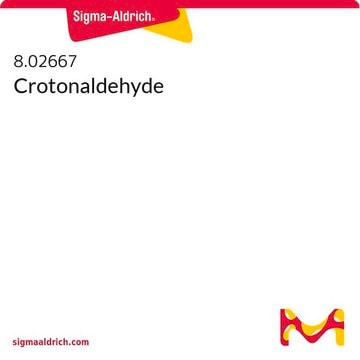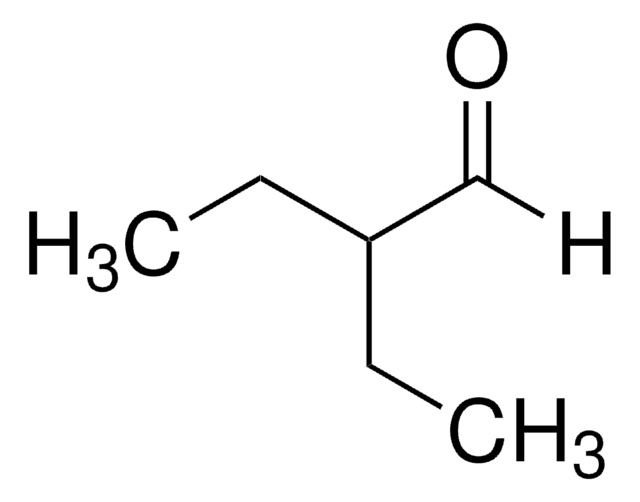In this case, the term "predominantly trans" is not specifically defined, but based on analysis of previous lots, it appears to be between 95% and 98% trans. While this cannot be guaranteed for future lots, historical data suggests this range. It could be a helpful estimation to consider.
Kluczowe dokumenty
262668
Crotonaldehyde, predominantly trans
≥99%, contains 0.1-0.2% BHT as stabilizer, 1% H2O as stabilizer
Synonim(y):
(2E)-2-Butenal, (E)-But-2-en-1-al, 2(E)-Butenal, trans-2-Buten-1-al, trans-2-Butenal, trans-Crotonal
Wybierz wielkość
220,00 zł
Wybierz wielkość
About This Item
220,00 zł
Polecane produkty
gęstość pary
2.41 (vs air)
Poziom jakości
ciśnienie pary
32 mmHg ( 20 °C)
Próba
≥99%
Formularz
liquid
temp. samozapłonu
320 °F
zawiera
0.1-0.2% BHT as stabilizer
1% H2O as stabilizer
granice wybuchowości
19.5 %
współczynnik refrakcji
n20/D 1.4362 (lit.)
bp
104 °C (lit.)
mp
−76 °C (lit.)
rozpuszczalność
water: soluble 425.4 g/L at 20 °C
gęstość
0.846 g/mL at 25 °C (lit.)
grupa funkcyjna
aldehyde
temp. przechowywania
2-8°C
ciąg SMILES
[H]\C(C)=C(\[H])C([H])=O
InChI
1S/C4H6O/c1-2-3-4-5/h2-4H,1H3/b3-2+
Klucz InChI
MLUCVPSAIODCQM-NSCUHMNNSA-N
Szukasz podobnych produktów? Odwiedź Przewodnik dotyczący porównywania produktów
Opis ogólny
Zastosowanie
- Crotonaldehyde (Cis and Trans): Discusses the production and properties of crotonaldehyde, including trans isomer, via aldol condensation of acetaldehyde and catalytic methods (Grant & Jenkins, 2015).
- Modeling, simulation and analysis of a process for the production of crotonaldehyde: Analyzes the production of crotonaldehyde, highlighting the stereoisomeric forms, including trans-crotonaldehyde (Scheithauer et al., 2016).
Hasło ostrzegawcze
Danger
Zwroty wskazujące rodzaj zagrożenia
Zwroty wskazujące środki ostrożności
Klasyfikacja zagrożeń
Acute Tox. 1 Inhalation - Acute Tox. 3 Dermal - Acute Tox. 3 Oral - Aquatic Acute 1 - Eye Dam. 1 - Flam. Liq. 2 - Muta. 2 - Skin Irrit. 2 - STOT RE 2 - STOT SE 3
Organy docelowe
Respiratory system
Kod klasy składowania
3 - Flammable liquids
Klasa zagrożenia wodnego (WGK)
WGK 3
Temperatura zapłonu (°F)
48.2 °F - closed cup
Temperatura zapłonu (°C)
9 °C - closed cup
Środki ochrony indywidualnej
Eyeshields, Faceshields, Gloves, type ABEK (EN14387) respirator filter
Wybierz jedną z najnowszych wersji:
Masz już ten produkt?
Dokumenty związane z niedawno zakupionymi produktami zostały zamieszczone w Bibliotece dokumentów.
Klienci oglądali również te produkty
-
What does "predominantly trans" mean for product 262668? Is there any guidance available on the amount of trans compared to cis?
1 answer-
Helpful?
-
Active Filters
Nasz zespół naukowców ma doświadczenie we wszystkich obszarach badań, w tym w naukach przyrodniczych, materiałoznawstwie, syntezie chemicznej, chromatografii, analityce i wielu innych dziedzinach.
Skontaktuj się z zespołem ds. pomocy technicznej













